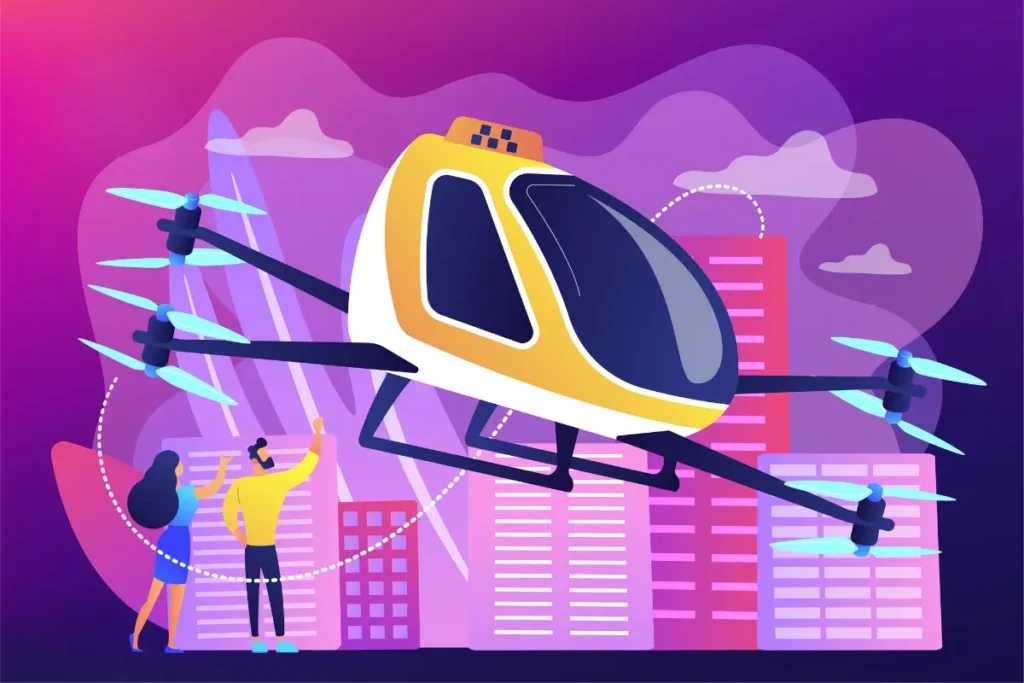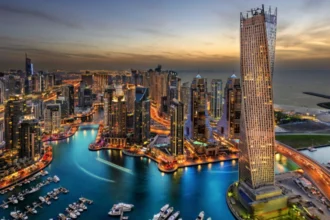November 19, 2025 | Dubai, UAE: Dubai is flying into the future of movement with the First Flying Taxi in Dubai, as it is now 60 percent finished on the first vertiport in Dubai, where the first flying taxi in Dubai will operate, soon, in 2026, outside of Dubai International Airport (DXB).
A Vertiport Like No Other
The project “ The first flying taxi in Dubai”, which Skyports Infrastructure is contracting with the Roads and Transport Authority (RTA) will provide, will provide a four-storey building covering around 3,100 square metres. The two of the said floors will contain parking space and take-off/landing pads, whereas the other levels will contain electric aircraft charging infrastructure and fully air-conditioned passenger areas.

Importantly, this facility of the First flying taxi in Dubai will have the capacity to accommodate close to 42,000 landings annually and accommodate close to 170,000 passengers annually after the installation of the system. Practically, the city is establishing a foundation to an enormous change in the way individuals will travel on roads to the skies.
The implementation of the First Flying Taxi in Dubai
Even the proposed service is not a one-off novelty: the planned service is part of a larger mobility ecosystem. The vertiport has been connected by the RTA to a network of other destinations within the Dubai Mall/Zabeel, Palm Jumeirah (through Atlantis The Royal) and Dubai Marina which constitute the backbone of what is proposed to be the first electric aerial taxi route network in Dubai.
The commute between Dubai international Airport and Palm Jumeirah is therefore supposed to last approximately 10 minutes on an aerial taxi, as opposed to about 45 minutes on the road currently. And the system is being modeled to be connected with the current transport modes, including the public transit, e-scooters and bikes.
The Airplane and Technology behind it.
The actual aerial taxis are being designed by the company Joby Aviation and use electric vertical take-off and landing (eVTOL) technology: four passengers (including pilot) on board, six rotors, four battery packs, with a top speed of 320 km/h and a range of up to 160 km, and making less noise than traditional helicopters.

The latest accomplishment of a crewed flight between two points in the UAE by Joby crewed eVTol flight was a key milestone to the project and the RTA.
Why This Matters
The first flying taxi in Dubai matters because of:
Mobility transformation: Dubai is also on the edge of the so-called advanced aerial mobility, it allows flying quickly and electrically in the city.
Sustainability: The application of electric aircrafts and special vertiports is a sign of abandoning the old-fashioned carbon-intensive services of helicopters and taxis.
Tourism & business attractiveness: The reduction in the travel period by several folds and provision of futuristic experiences will underpin the image of Dubai as an innovation centre.
Congestion reduction in the cities: As people use roads less to make some of their high-value short hikes, the total demand on the ground transport networks can be reduced.
Although the vision is ambitious, the aerial taxi scaling creates several issues:
Regulation & safety: Owing to the safety-related requirements of ensuring safe operations of eVTOLs within the most densely populated city airspace presupposes effective regulatory frameworks and air-traffic controllers.
Infrastructure deployment: Past the initial vertiport, it is quite an arduous logistical task to construct and bring the entire network to a functioning state promptly.
Price and demand: In the early stages of its development, high-speed aerial taxi flights can be charged higher rates; the ideal scenario will be prevalence and acceptance by the society.
Noise, visual effect and social acceptance: Despite reduced noise eVTols, the issue of aerial mobility is a social concern that needs to be dealt with first.
Reaching the 60 percent completion mark, Dubai has made a real stride towards the introduction of the first flying taxi in Dubai. The commercial operations target will be 2026 for the first flying taxi in Dubai. With the vertiport being more complete and the eVTOL technology becoming more certified and tested, in the near future we would watch commuters, travellers and even tourists embark on electric aerial taxis to get downtown, beaches, airports and the rest, and that is how the concept of travelling in a really modern city would be redefined.

Dubai is not only thinking about flying taxi service, it is constructing the infrastructure, technology and regulatory ecosystem to make it possible. The next few years will determine how extensive the vision will go, how cost-effective it will be, and how the world will react to the new age of urban aerial transport.
Read: 54th UAE National Day Celebrations Kick Off with Sharjah’s Two-Week Festivities

















